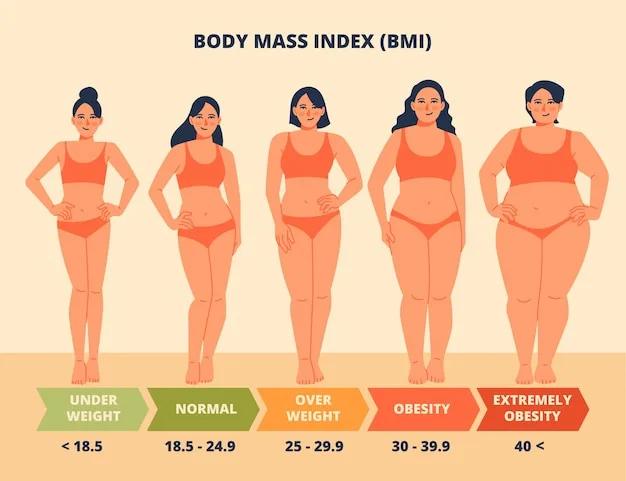
December 22, 2025 (Current Version)
March 28, 2025
Body Mass Index (BMI) is a widely used measure for obesity or being overweight, calculated using a person’s body weight and height. It provides an estimate of body fat and helps determine if an individual is underweight, at a healthy weight/normal weight, overweight, or obese. A BMI of 30 or over is considered as having obesity.
Obesity is divided into three classes called Class I, Class II and Class III. Each class of obesity has an increasing BMI value with health risks increasing as BMI goes up. Lets take a look into what Class I obesity is and ways to prevent falling into this category of obesity.
📝 The BMI scale
BMI is calculated by dividing a person’s weight in kilograms by the square of their height in metres. BMI calculators are available online as a starting point to work out obesity class, but they are not a substitute for medical advice from your healthcare provider.
Class 1 is the least severe class, while class 3 is the most severe. The Centers for Disease Control and Prevention (CDC) define BMI ranges as:
- Underweight: (BMI) of less than 18.5kg/m2
- Healthy weight/normal weight: BMI of 18.5-25 kg/m2
- Overweight: BMI 25-30 kg/m2 (not obese)
- Class I Obesity: BMI 30-35 kg/m2 (low risk)
- Class II Obesity: BMI 35-40 kg/m2 (moderate risk)
- Class III Obesity: BMI ≥ 40.0 kg/m2 (high risk)
The above BMI cut off points are based on Caucasians and do not consider ethnicity, gender or age. Different countries and ethnicities have different cut-offs for obesity, especially people who have Chinese, African Caribbean, Black African, and South Asian backgrounds. Your healthcare provider can discuss the differences with you.
📝 What BMI range qualifies as Class 1 obesity?
Class I obesity is also called low obesity and is the first classification on the BMI scale. Individuals who have a body mass index between 30 and 35 have Class I obesity.
Increased risk of health problems
People who fall into this category may not have any known weight related complications and live a good quality of life, but may still have unhealthy amounts of excess body fat. This must be kept in mind, that having Class 1 obesity still puts individuals at a higher risk of developing health conditions such as:
- Type 2 diabetes
- Heart disease
- High blood pressure (hypertension)
- Mental health risks
- Sleep apnea
- Osteoarthritis
- High cholesterol
📝 Treatment for Class 1 obesity
The most effective treatment for class 1 obesity is weight loss and a reduction in your BMI level to a healthy weight range of between 18.5 and 25. Taking steps to reduce your risk factors is critical to prevent reaching severe obesity.
🍽️ Healthy eating
What to eat:
Eating a balanced healthy diet with plenty of fruits, vegetables, lean protein sources, whole grains and healthy fats. Avoiding processed foods high in sugar or saturated fat.
Lean protein sources like chicken breast and fish, vegetables like spinach and broccoli, and fruits like berries and bananas are all excellent healthy food options, that are both delicious and nutrient-dense.
What not to eat:
Highly processed foods such as sweetened drinks, crisps, packaged cakes and biscuits, ready meals. These foods can add excess calories, sodium, sugars and saturated fat to your diet contributing to excess weight gain.
Portion control:
Portion control is an essential element to prevent weight gain. Consuming fewer calories than your body needs is vital for achieving healthy weight loss. But, how can you do that? Use smaller plates, measure your food using a food scale or measuring cups, avoid eating directly from packages as it can lead to mindless eating.
Healthy swaps:
A few simple food swaps can make a big difference. One of the key changes you can make is to start replacing saturated fats with unsaturated fats. Instead of reaching for butter, try cooking with olive oil or avocado oil. Swap out fatty meats for leaner protein sources, such as chicken breast or fish. Swap regular pasta for spaghetti squash or zucchini noodles. Similarly, you can replace high-fat dairy products with low-fat or fat-free options, like skimmed milk or Greek yoghurt.
👟 Physical activity
Physical activity plays a crucial role in body weight management. Regular exercise helps burn calories, increase metabolism, build lean muscle mass and maintain a healthy weight.
Regular physical activity strengthens the heart, elevates heart rate and improves cardiovascular health. It helps lower blood pressure, reduce the risk factors of cardiovascular disease and stroke and improve overall cardiovascular fitness. Aerobic exercises such as brisk walking, running, swimming and cycling are particularly effective in promoting heart health.
Studies have shown that regular physical activity can help prevent and manage chronic diseases such as metabolic syndrome, certain types of cancer and osteoporosis. Exercise improves insulin sensitivity, reduces inflammation and enhances immune function, thereby reducing the risk of these medical conditions.
Making these small changes to your diet and lifestyle can help you achieve a healthier BMI, improve your overall health and move from Class 1 obesity to a healthy weight range.
📝 Conclusion
Weight loss is often much harder to achieve alone. Thankfully, there are dietitians and healthcare professionals who can guide us in making informed decisions to prevent creeping up the obesity scale. When putting together a weight management plan, it is important to consider the number of calories in the foods we consume and increasing your activity levels.
Sources
- Adult BMI Categories | BMI | CDC
- Your weight and heart and circulatory conditions – BHF
- A healthy lifestyle – WHO recommendations
Medical Disclaimer
NowPatient has taken all reasonable steps to ensure that all material is factually accurate, complete, and current. However, the knowledge and experience of a qualified healthcare professional should always be sought after instead of using the information on this page. Before taking any drug, you should always speak to your doctor or another qualified healthcare provider.
The information provided here about medications is subject to change and is not meant to include all uses, precautions, warnings, directions, drug interactions, allergic reactions, or negative effects. The absence of warnings or other information for a particular medication does not imply that the medication or medication combination is appropriate for all patients or for all possible purposes.








